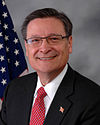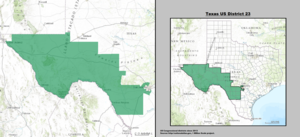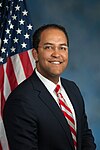Texas's 23rd congressional district
| Texas's 23rd congressional district | |||
|---|---|---|---|
 Texas's 23rd congressional district since January 3, 2013 | |||
| Representative |
| ||
| Distribution |
| ||
| Population (2019) | 786,712[2] | ||
| Median household income | $59,074[2] | ||
| Ethnicity |
| ||
| Cook PVI | R+1[3] | ||
Texas's 23rd congressional district stretches across the southwestern portion of Texas. It is a majority Hispanic district and has been represented by Republican Tony Gonzales since 2021.
Election results from statewide races[]
| Year | U.S. President | U.S. Senator | Governor |
|---|---|---|---|
| 2004 | Bush (R): 57 - 43% | — | — |
| 2008 | Obama (D): 51 - 48% | Cornyn (R): 50 - 47.7% | — |
| 2012 | Romney (R): 51 – 48% | Cruz (R): 51.7 – 45.3% | — |
| 2016 | Clinton (D): 50 – 46% | — | — |
| 2018 | — | O'Rourke (D): 51.3 – 47.8%[4] | Abbott (R): 52.9 – 45.7% |
| 2020 | Trump (R): 50.2 – 48.4% | — | — |
Geography[]
The district runs along the majority of Texas's border with Mexico, just north of the Rio Grande. It stretches from western San Antonio to just outside El Paso, and while it encompasses numerous county seats and a few towns of regional economic importance, the district is predominantly rural. It is very difficult to campaign in due to its large size and few unifying influences, and the population density is one of the lowest of any congressional district. Major economic activities in the district include farming, ranching, oil and mineral extraction, recreation, manufacturing, and tourism, as it encompasses all of Big Bend National Park and Big Bend Ranch State Park.
Demographics[]
According to the APM Research Lab's Voter Profile Tools (featuring the U.S. Census Bureau's 2019 American Community Survey), the district contained about 511,000 potential voters (citizens, age 18+). Of these, 64% are Latino, while 29% are White. One in ten potential voters were born outside of the U.S., now naturalized citizens. Median income among households (with one or more potential voter) in the district is about $61,800, while 11% of households live below the poverty line. As for the educational attainment of potential voters in the district, 17% of those 25 and older have not earned a high school degree, while 23% hold a bachelor's or higher degree.
Election results[]
Elections from 1967 to 1992[]
This district was created in 1967, following passage of the Voting Rights Act of 1965. In addition, it followed the case of Wesberry v. Sanders, resulting in Texas's previous congressional map being tossed out. Democrats held the district until 1993.
Elections from 1992 to 2002[]
Following the 1990 census, in 1992, the Texas Legislature created the new 28th district, mostly from the eastern portion of the 23rd. In the process, the legislature left a heavily Republican section of western San Antonio in the 23rd. Republican Henry Bonilla beat 4-term incumbent Albert Bustamante to take the seat in 1992.
Although the 23rd leaned slightly Democratic on paper, Bonilla had a very conservative voting record. Largely because of his popularity in San Antonio, he did not face a credible challenger until 2002, when the former Democratic Texas Secretary of State, Henry Cuellar, came within 2 points of unseating him.
2004 election[]
During the 2003 Texas redistricting, the Republican-controlled Texas Legislature shifted most of Laredo, which had been one of the bases of the 23rd from the beginning, into the 28th district. Several heavily Republican suburbs in the Texas Hill Country north of San Antonio were shifted into the 23rd district, all but ensuring Bonilla of a seventh term.
| Party | Candidate | Votes | % | ±% | |
|---|---|---|---|---|---|
| Republican | Henry Bonilla (incumbent) | 170,716 | 69.3 | +17.7 | |
| Democratic | Joe Sullivan | 72,480 | 29.4 | -17.8 | |
| Libertarian | Nazirite Perez | 3,307 | 1.3 | +0.6 | |
| Majority | 98,236 | 39.9 | |||
| Turnout | 246,503 | ||||
| Republican hold | Swing | +17.8 | |||
2006 election[]
On June 28, 2006, the U.S. Supreme Court, in League of United Latin American Citizens v. Perry ruled that the 23rd district violated the Voting Rights Act of 1965. The case turned on the fact that the 23rd district was a protected majority-Hispanic district. If the 23rd were redrawn to put Hispanics in a minority, a new majority-Hispanic district had to be created. Although Hispanics made up 55 percent of the old 23rd's population, they comprised only 46 percent of the new 23rd's voting-age U.S. citizen population. Therefore, the Court said, the new 23rd was not a true majority-minority district. The Court found that the new Austin-to-McAllen 25th district was not compact enough to be an acceptable replacement. The Court ruled that the legislature had violated the rights of Hispanic voters.
As a result, on August 4, 2006, a three-judge panel announced replacement district boundaries for the 2006 election in the 23rd district. Due to the 23rd's size, nearly every district along the El Paso-San Antonio corridor had to be redrawn as well.
In the change, the new 23rd lost many of the heavily Republican areas given to it in 2003, as well as the rest of Laredo. It received a large portion of south San Antonio, which was heavily Democratic. Four other districts were affected: the 28th (represented by Democrat Henry Cuellar), 25th (Democrat Lloyd Doggett), 15th (Democrat Ruben Hinojosa) and 21st (Republican Lamar S. Smith). As a result, on November 7, 2006 (the day of the general election), these five districts held open primaries, called a "jungle primary." If no candidate were to receive as much as 50% of the vote, a runoff election in December would decide the seat.[5]
In the 23rd, the incumbent Bonilla had two significant opponents, both Democrats: the Vietnam War veteran and Ciro Rodriguez, the former Congressman of the 28th district. In the Spring, Bolanos won the now moot 23rd district Democratic primary. Rodriguez lost a primary challenge to Cuellar in the 28th district, which was also vacated. The redrawing placed Rodriguez's home, along with most of his old base, into the 23rd district. Other candidates in the special election were: , the retired San Antonio Fire Department district chief and brother of the state Senator Carlos Uresti; , a rancher and businessman from Alamo Heights; Adrian De Leon, the owner of a truck stop in Carrizo Springs; and of San Antonio. , an independent candidate, also filed to run.[6]
Rick Bolanos dropped out of the race on October 19, 2006 and endorsed fellow Democrat Lukin Gilliland.
On November 7, 2006, Henry Bonilla received significantly more votes than any of his challengers, but did not receive 50% of the votes cast. Though none of the Democratic candidates came close to Bonilla individually, as a whole the six Democratic candidates received slightly more votes than Bonilla, the only Republican candidate. However, neither party received more than 50% of the vote because of a third party candidate.
A runoff election was held on December 12, 2006 between Bonilla and Rodriguez, and Rodriguez won.[7]
| Party | Candidate | Votes | % | ±% | |
|---|---|---|---|---|---|
| Democratic | Ciro Rodriguez | 38,247 | 54.32% | +25.1 | |
| Republican | Henry Bonilla (Incumbent) | 32,165 | 45.68% | -23.9 | |
| Majority | 6,082 | 8.64% | |||
| Turnout | 68,294 | ||||
| Democratic gain from Republican | Swing | 24.5 | |||
2010 election[]
The National Republican Congressional Committee targeted Texas's 23rd congressional district to try to regain it, and strongly supported the Republican campaign financially.[8] Francisco "Quico" Canseco, a San Antonio businessman, became the Republican nominee for the district after defeating Will Hurd, Robert Lowry, Joseph Mack Gould, and Michael Kueber in the Republican primary.[9] Canseco won the General Election on November 2, 2010, defeating the incumbent, and took office on January 3, 2011.[10]
| Party | Candidate | Votes | % | ±% | |
|---|---|---|---|---|---|
| Republican | Quico Canseco | 74,671 | 49.38 | ||
| Democratic | Ciro Rodriguez (incumbent) | 67,212 | 44.44 | ||
| Majority | |||||
| Turnout | 141,883 | ||||
| Republican gain from Democratic | Swing | ||||
2012 election[]
Democratic challenger Pete Gallego defeated Republican incumbent Quico Canseco in the race for Texas's 23rd district on November 6, 2012. Since 1991, Gallego had represented the 74th state house district, which is the nation's largest United States-Mexico border district.[12] At one time or another, Gallego had represented nearly all of the central portion of the congressional district.
Canseco conceded the race on November 9.[13]
| Party | Candidate | Votes | % | |
|---|---|---|---|---|
| Democratic | Pete Gallego | 96,477 | 50.33 | |
| Republican | Quico Canseco (incumbent) | 87,255 | 45.52 | |
| Libertarian | Jeffrey C. Blunt | 5,827 | 3.04 | |
| Green | Ed Scharf | 2,099 | 1.09 | |
| Total votes | 191,658 | 100 | ||
2014 election[]
Republican challenger Will Hurd defeated Democratic incumbent Pete Gallego in the race for Texas's 23rd district on November 4, 2014, making this the third consecutive election in which partisan control of the seat switched.
| Party | Candidate | Votes | % | |
|---|---|---|---|---|
| Republican | Will Hurd | 57,459 | 49.8 | |
| Democratic | Pete Gallego (incumbent) | 55,037 | 47.7 | |
| Libertarian | Ruben Corvalan | 2,933 | 2.5 | |
| Total votes | 115,429 | 100 | ||
2016 election[]
Republican incumbent Will Hurd defeated Democratic challenger Pete Gallego in the race for Texas's 23rd district on November 8, 2016.
| Party | Candidate | Votes | % | |
|---|---|---|---|---|
| Republican | Will Hurd (incumbent) | 110,577 | 48.3 | |
| Democratic | Pete Gallego | 107,526 | 47.0 | |
| Libertarian | Ruben Corvalan | 10,862 | 4.7 | |
| Total votes | 228,965 | 100 | ||
2018 election[]
Republican incumbent Will Hurd won a close election for a third consecutive time, defeating newcomer Gina Ortiz Jones by a margin of fewer than 1,000 votes on November 6, 2018.
| Party | Candidate | Votes | % | |
|---|---|---|---|---|
| Republican | Will Hurd (incumbent) | 103,285 | 49.2 | |
| Democratic | Gina Ortiz Jones | 102,359 | 48.7 | |
| Libertarian | Ruben Corvalan | 4,425 | 2.1 | |
| Total votes | 210,069 | 100.0 | ||
| Republican hold | ||||
2020 election[]
Republican candidate Tony Gonzales won an unexpected victory over second-time candidate Gina Ortiz Jones by a margin of 4%.
| Party | Candidate | Votes | % | |
|---|---|---|---|---|
| Republican | Tony Gonzales | 149,395 | 50.6 | |
| Democratic | Gina Ortiz Jones | 137,693 | 46.6 | |
| Libertarian | Beto Villela | 8,369 | 2.8 | |
| Total votes | 295,457 | 100 | ||
| Republican hold | ||||
List of members representing the district[]
| Member | Party | Years | Cong ress |
District home | Electoral history | District location |
|---|---|---|---|---|---|---|
| District created January 3, 1967 | ||||||
 Abraham Kazen Jr. |
Democratic | January 3, 1967 – January 3, 1985 |
90th 91st 92nd 93rd 94th 95th 96th 97th 98th |
Laredo | Elected in 1966. Re-elected in 1968. Re-elected in 1970. Re-elected in 1972. Re-elected in 1974. Re-elected in 1976. Re-elected in 1978. Re-elected in 1980. Re-elected in 1982. Lost renomination. |
1967–1973: [data unknown/missing] |
| 1973–1983: [data unknown/missing] | ||||||
| 1983–1993: [data unknown/missing] | ||||||
 Albert Bustamante |
Democratic | January 3, 1985 – January 3, 1993 |
99th 100th 101st 102nd |
San Antonio | Elected in 1984. Re-elected in 1986. Re-elected in 1988. Re-elected in 1990. Lost re-election. | |
 Henry Bonilla |
Republican | January 3, 1993 – January 3, 2007 |
103rd 104th 105th 106th 107th 108th 109th |
San Antonio | Elected in 1992. Re-elected in 1994. Re-elected in 1996. Re-elected in 1998. Re-elected in 2000. Re-elected in 2002. Re-elected in 2004. Lost re-election. |
1993–2003: [data unknown/missing] |
| 2003–2005: [data unknown/missing] | ||||||
2005–2007:
| ||||||
 Ciro Rodriguez |
Democratic | January 3, 2007 – January 3, 2011 |
110th 111th |
San Antonio | Elected in 2006. Re-elected in 2008. Lost re-election. |
2007–2013:
|
 Quico Canseco |
Republican | January 3, 2011 – January 3, 2013 |
112th | San Antonio | Elected in 2010. Lost re-election. | |
 Pete Gallego |
Democratic | January 3, 2013 – January 3, 2015 |
113th | Alpine | Elected in 2012. Lost re-election. |
2013–present:
|
 Will Hurd |
Republican | January 3, 2015 – January 3, 2021 |
114th 115th 116th |
Helotes | Elected in 2014. Re-elected in 2016. Re-elected in 2018. Retired. | |
 Tony Gonzales |
Republican | January 3, 2021 – Present |
117th | San Antonio | Elected in 2020. | |
See also[]
References[]
- ^ Geography, US Census Bureau. "Congressional Districts Relationship Files (state-based)". www.census.gov.
- ^ a b Center for New Media & Promotion (CNMP), US Census Bureau. "My Congressional District". www.census.gov.
- ^ "Partisan Voting Index – Districts of the 115th Congress" (PDF). The Cook Political Report. April 7, 2017. Retrieved April 7, 2017.
- ^ "Texas 2018 Senate and governor by Congressional District". Google Docs. Retrieved December 30, 2019.
- ^ "Texas Redistricting", Austin American-Statesman, 4 August 2006
- ^ Matthew Spieler (August 31, 2006). "Rodriguez Drops Bid in Texas 23, But Only Briefly". Archived from the original on October 27, 2006. Retrieved September 1, 2006.
- ^ [1][permanent dead link]
- ^ "NRCC Memo Reveals 24 Democratic Targets". Roll Call. March 6, 2008. Retrieved August 29, 2010.
- ^ Flores, Canseco win GOP nods Politico April 14, 2010. Retrieved April 15, 2010.
- ^ TX Secretary of State TX Secretary of State Election Returns November 2, 2010. Retrieved November 3, 2010.
- ^ "2010 General Election, Election Night Returns, Unofficial Elections Results As Of: 11/3/2010 12:14:58 PM". Texas Secretary of State. November 3, 2010. Retrieved November 22, 2010.[permanent dead link]
- ^ "Democrat Takes The Texas 23rd Congressional District". KPBS. November 7, 2012. Retrieved November 8, 2012.
- ^ Martin, Gary (November 9, 2012). "Canseco concedes to Gallego in District 23". San Antonio Express-News. Retrieved May 6, 2015.
- ^ "Texas Election Results". Texas Secretary of State. Retrieved December 5, 2018.
- ^ "Texas Election Results: 23rd Congressional District". New York Times. Retrieved May 2, 2021.
Further reading[]
- Amber Phillips (September 25, 2020), "The House seats most likely to flip in November", Washingtonpost.com
External links[]
Coordinates: 30°23′21″N 102°19′36″W / 30.38917°N 102.32667°W
- Congressional districts of Texas
- Laredo, Texas